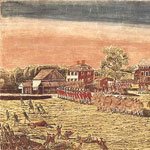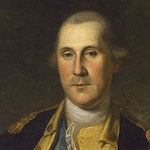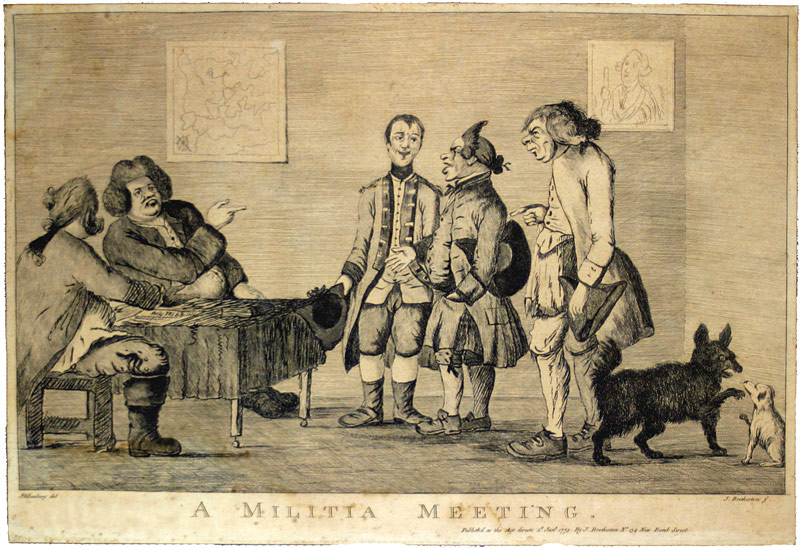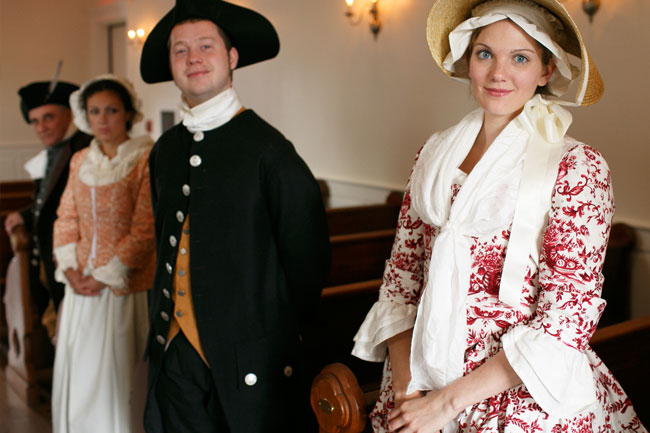When news of the Boston Tea Party reached London in 1774, Parliament immediately focused their energies on punishing the recalcitrant colonists. Starting in June of that year, the port of Boston would be closed to all commerce until the cargoes of tea had been paid for by the town. Reflecting on the hardships they were about to suffer, John told Abigail “We live my dear soul, in an age of trial.” In the months that followed, other acts would take effect that were also intended to break the resolve of the patriots. More troops were sent to Boston, the Massachusetts Charter was revoked, and the Administration of Justice Act enabled the Royal Governor to remove trials from Massachusetts to Great Britain. People in Massachusetts were outraged, and due to the invasive nature of the laws, they started to refer to the collection of acts known as the Coercive Acts as the Intolerable Acts.
- Intolerable Acts
- Battle of Lexington & Concord
- Battle of Bunker Hill
- Second Continental Congress
- Olive Branch Petition
- Washington Prepares
- Declaration of Independence
- Thomas Paine's Common Sense
- Washington Fights
- Battle of New York
- American Delegation
- Peace Talks
- Miliary Force
- Reinforcements
- Board of War
- Battle of Fort Washington
- British Troops Rest
- Washington Crossing the Delaware
- Congress Flees
- Valley Forge
John Adams & The Revolutionary War
The Intolerable Acts
The Intolerable Acts did not just offend colonists from Massachusetts, but also triggered a response from the other colonies as well. In September of 1774, the First Continental Congress started meeting in Philadelphia, and John Adams was chosen by the legislature to be one of five delegates representing Massachusetts. Before he departed for Philadelphia, John rode the circuit one last time. On break, he visited Falmouth, Massachusetts (today known as Portland, Maine) where he connected with an old friend, Jonathan Sewall, who was still the Attorney General of Massachusetts. Sewall, who was a fierce loyalist, begged Adams to reconsider his decision to attend the First Continental Congress. Sewall reminded Adams of the redoubtable army and navy the British had at their disposal, and did his best to convince Adams that British power was irresistible. John had long since made up his mind. “Swim or sink, live or die, survive or perish, [I am] with my country…You may depend upon it.”
The Battle of Lexington & Concord
In a series of letters printed anonymously in the Boston Gazette, John Adams warned readers that if they allowed the British Parliament to trample their rights, they would meet the same fate as the Irish—in a state of subjugation, and compelled to live on potatoes and water. In the months that followed, the Americans would take such ominous warnings to heart as they started to prepare for war. In Concord, provincial militiamen started to gather arms and gunpowder in preparation for a confrontation with the British Army. On April 19, 1775, the day of reckoning came. Receiving reports that the colonists were hoarding arms in order to supply a provincial army of rebels, General Thomas Gage dispatched approximately seven hundred redcoats to Concord. In the early morning hours of April 19, Captain John Parker and a collection of militiamen blocked their way at Lexington Green, where the first battle of American Revolution unfolded. No one was certain who fired the first shot, but by the end of the day, nearly four thousand Massachusetts militiamen had encircled the British regulars, and chased them back to Boston where they surrounded the town by land.
The Battle of Bunker Hill
About two months later, with the arrival of three British generals—William Howe, Henry Clinton and John Burgoyne—the British resumed the assault at Bunker Hill. The British generals planned to break the encirclement by first striking north of Boston. From there they would be able to send soldiers out into the countryside again where they could gather the necessary provisions to resupply their army. The battle opened with a bombardment of Bunker Hill and Charlestown, after which waves of soldiers were to be ferried across the Charles River where they would march up Breed’s Hill to face the militiamen. On the third and final assault, the British took the ground, leaving Adams’ friend, and physician Dr. Joseph Warren mortally wounded.
Adams Attends the Second Continental Congress
By now, John Adams was attending the Second Continental Congress. At this time, delegates to the congress were not decided on whether or not the formation of an independent army was the best route to take. As far as Adams was concerned, the founding of an army and a declaration of independence were necessary to defend to colonists against British aggression. “Powder and artillery are the most efficacious, sure and infallible conciliatory measures we can adopt” Adams declared.
While there were other delegates who believed in Adams’ vision, delegates such as John Dickinson were opposed to such belligerent overtones. In a speech to Congress, Dickinson alleged that if the conflict turned into a war, the New England delegates would have “blood on their heads.” Adams was opposed to Dickinson’s proposed measures of reconciliation, and publicly challenged him on the floor. After the session, Dickinson approached Adams to ask him “What is the reason, Mr. Adams, that you New England men oppose our measures of reconciliation?” Dickinson warned Adams that if he stood opposed to their “pacific system” that “I, and a number of us, will break off from you in New England and we will carry on the opposition by ourselves in our own way.”
For several months, Dickinson had championed petitioning Parliament and King George III with the colonists’ grievances. He believed that if they could be made to understand the colonists’ point of view, then they would repeal the acts of taxation, and recall the British regulars. But Adams did not believe that such an outcome was realistic. He was the first to remind Congress of the British regulars’ transgressions at the Battle of Lexington and Concord, and of the most recent bloody engagement at the Battle of Bunker Hill. While Adams was convinced that the colonists should waste no time in forming a new government, and establishing a standing army; other delegates were not ready to take that leap. For if they did, there was a general understanding that there would be no turning back.
The Olive Branch Petition
In an effort to make one last attempt to reach a peaceful reconciliation with the mother country, delegates to the Second Continental Congress debated and signed the Olive Branch Petition on July 8, 1775. While the delegates continued to attempt reconciliation, they also established the Continental Army on June 14, 1775, and nominated George Washington to lead it. They also opened American ports to trade in violation of British law, and even discussed establishing a national currency. However, the Second Continental Congress was not the government, and while they assumed many of these responsibilities, they did so with the intention of eventually reaching an accord with the mother country. On August 23, 1775 these dreams were dashed. King George refused to accept the Olive Branch Petition, and instead signed a Royal Proclamation which declared the colonies to be in a state of rebellion.
As Congress continued to assume the responsibilities of government, Henry Knox was making his way through the snow swept mountains of western Massachusetts. Just a few weeks earlier, Knox had removed the cannons from Fort Ticonderoga with the intention of bringing them to Boston, Massachusetts, where they could be used to dislodge the British fleet and army. On the morning of March 17, 1776, with Knox’s canons pointed down at them from the top of Dorchester Heights, the British Army evacuated Boston, and set sail for Halifax where they would resupply and carry on the fight elsewhere.
Washington Prepares for Battle
No one was sure where Howe would reemerge with his army, but Washington was convinced they would strike next at New York. With this in mind, he moved the Continental Army south, and left a detachment to defend Manhattan, while another force would hold Brooklyn Heights. On May 24, 1776, George Washington appeared before Congress to remind them of his perilous situation. Around this time, people were aware that Howe would sail to New York with the army from Boston, in addition to 17,000 Hessian mercenaries. Washington only had 7,000 soldiers under his command, and was in desperate need of supplies. Washington was hopeful that Congress could pull together the necessary resources to keep his army at fighting strength.
The Decision to Declare Independence
In late May, news arrived in Philadelphia that the Virginia convention had decided that the best course of action for the colonies would be to declare independence. John Adams was elated at hearing the news. On June 7, Richard Henry Lee stood to address the Congress:
“Resolved…That these United Colonies are, and of a right ought to be, free and independent states, that they are absolved from any allegiance to the British Crown, and that all political connection between them and the state of Great Britain is, and ought to be, totally dissolved.”
John Adams immediately seconded the motion and starting on June 8, the matter was open for debate. While Congress waited for its delegates to receive instruction from their provincial bodies, no time was wasted in drafting a declaration of independence. For this purpose a committee was appointed and was to be composed of Roger Sherman, Benjamin Franklin, John Adams, Robert Livingston and Thomas Jefferson. When it came to actually writing the document, the task was left to Jefferson, and for a valid reason. Jefferson proposed that Adams write the declaration, but Adams declined. When Jefferson asked why he had refused such an honor, Adams replied “Reason first: You are a Virginian and a Virginian ought to appear at the head of this business. Reason second: I am obnoxious, suspected and unpopular. You are very much otherwise. Reason third: You can write ten times better than I can.” So Jefferson set to work.
Thomas Paine Publishes Common Sense
That summer, a sensational pamphlet was printed in Philadelphia. First appearing on July 9, 1776, Common Sense appealed to the masses by way of its simple and plainspoken ideas. Written by Thomas Paine, a corset maker from England, Common Sense criticized the idea of hereditary monarchy, and laid the blame for the dispute between England and her colonies squarely on the shoulders of King George III. It was a declaration of war. The pamphlet urged Americans to take up arms and fight for their liberties.
Common Sense caused a sensation in the thirteen colonies. Ordinary people were now taking up arms in defense of their rights, and there was a general clamor for a declaration of independence like never before. While Paine was writing Common Sense, Congress was debating the notion of independence. On July 2, 1776 independence was adopted by twelve of the thirteen colonies, New York abstained from the ballot. The Declaration of Independence was to be authenticated and printed. The document, however, would not be signed by the delegates for a full month.
Washington Fights for Survival
Meanwhile, Washington was fighting for survival in New York. At the end of June, the fleet of British warships appeared off the coast of New York. On July 12, Admiral Howe of the Royal Navy dispatched two men of war to sail up the Hudson River, discharging their canons for all to see in a show of force. But Washington did not budge. Under his command it was now estimated that he had nearly 9,000 troops, all of which were poorly trained and ill equipped. These soldiers would be needed in defense of New York against the most powerful military in the world. A little over a month later, the British would attempt an assault on the Continental Army’s fortified positions at Brooklyn Heights.
The Battle of New York
On Thursday, August 22, nearly 15,000 British troops landed on Long Island. Unsure of where Howe planned to attack, Washington divided his forces between Manhattan and Long Island—Washington’s forces were split geographically by the East River. The British forces on Long Island waited three days before they commenced the invasion, and only then did they attack the American position on Brooklyn Heights. The Americans had never experienced combat on this scale. By the end of the day, the commanders of the Continental Army were outfoxed and outflanked. Nearly 1,000 Americans were killed, wounded, or taken prisoner, while the British Army lost only 400. To make matters worse, General John Sullivan of the Continental Army was taken prisoner.
“In general, our generals were outgeneralled.”
Sullivan would be used by Admiral Lord Richard Howe and his brother, General William Howe to be sent to Philadelphia in a feeble attempt to secure the surrender of American forces. Admiral Howe told Sullivan that he was under instruction from the British government that certain members of the Continental Congress would be pardoned if they surrendered. On August 31, 1776, Congress learned of Washington’s defeat at New York, but the delegates took solace knowing that Washington had escaped after the battle with nearly his entire force across the East River. The Continental Army would live to fight another day. Reflecting on the battle, Adams lamented “In general, our generals were outgeneralled.”
The American Delegation Arrives in New York
Just a few days later, the captured General John Sullivan appeared in Philadelphia. On September 3, Sullivan spoke in front of Congress, and explained to them that Admiral Lord Howe had sent him so that the British government and the Continental Congress could seek an accommodation. But John Adams had his suspicions. Turning to his friend Benjamin Rush, Adams opined that it would have been better if Sullivan had been shot through the head during the battle. Sullivan, standing before Congress asked that a commission might be sent to New York to meet with Lord Howe. Adams was initially opposed to the idea, believing that it would only make the Continental Congress appear weak. Moreover, Adams was opposed to making peace with the British commander. But when John Adams was asked to take part in the commission, he gladly consented.
The delegation was to consist of Edward Rutledge, Benjamin Franklin and John Adams. On September 11, they reached New York. The American delegation was met by one of Howe’s officers at Perth Amboy, who offered himself as a hostage to the Americans. He would, in his words, remain there as a guarantee that the Americans would not be taken as prisoners. Adams and Franklin, however, refused his offer, and so the officer followed them to the barge where they would be transported to the southernmost tip of Staten Island.
Peace Talks Fall Short
Admiral Lord Howe awaited them dressed in his most splendid military regalia. Howe, who was the chief naval officer in the North American theatre, was remarkably civil according to Adams. Realizing that his officer had not been taken prisoner, Howe remarked “Gentlemen, you make me a very high compliment, and you may depend upon it, I will consider it as the most sacred of things.” After exchanging customary bows, Howe led the Americans to a stone house just a short distance away. It was there that Howe, as was understood by the Americans, planned to offer them peace terms. Within minutes, the American delegation realized that Howe had been given no such authority to write the terms of a peace treaty, but rather, he was in possession of a list of names to be pardoned—a list that did not include John Adams. Admiral Howe and the Americans met for nearly three hours, but by the end of the ordeal no accord had been reached. Adams, Franklin and Rutledge left for Philadelphia, determined as ever to continue the fight for independence.
British Troops Unleash Military Force
General William Howe and Admiral Howe were now under no pretense that the Americans would surrender or agree to anything less than independence. On September 15, they unleashed the full furry of their military force. Howe dispatched five British warships to sail up the East River, and bombard American forces encamped on the west side of the river in Manhattan. Most of the men under siege were inexperienced, and at the time of the bombardment, most were drunk. When Howe’s warships opened the barrage, all fled away from the scene just as fast as their legs would carry them, leaving behind weapons, ammunitions, and other provisions that were in short supply to the Continental Army.
Washington Asks For Reinforcements
General George Washington was furious by the conduct of his unprofessional troops. During the retreat, Washington lost his patience, as he was seen riding up and down his lines ordering his men to return to the front. Washington had lost command of his soldiers, and while he wanted to remain at Manhattan, he was forced to join his army in the chaotic retreat. Washington was not optimistic about winning the war against the British war machine. In a letter to John Hancock, the President of the Continental Congress, Washington begged for reinforcements, for long-term enlistments, and for the supplies he needed to carry on the campaign.
Adams is Appointed to the Board of War
Congress appointed a committee to deal with the Continental Army’s dire circumstance. John Adams was appointed as head of the Board of War, and immediately started to press Congress for some of Washington’s requests. On September 16, Congress agreed to a new policy set forth by the Board of War which offered every soldier who signed on for the duration of the war $20, and 100 acres of land. At the very least, this might solve the Continental Army’s problem of desertion. In addition, Congress attempted to address the army’s issue with insubordination. In Washington’s letter to Hancock, he observed that “Men just dragged from the tender scenes of domestic life, unaccustomed to the din of arms, totally unacquainted with every kind of military skill…when opposed to troops regularly trained, makes them timid, and ready to fly from their own shadows.” For this reason, Congress increased the punishment for drunkenness on duty from thirty nine lashes to one hundred lashes. As head of the Board of War, Adams proposed the establishment of a professional military academy. While this proposal was brushed aside, Adams would be the first to make such a suggestion.
But as the summer of 1776 came to an end, it became obvious to all in Congress that more than an army of militiamen would be needed to vanquish their British foe. Humiliated at the Battle of New York, Washington was doing all he could to keep his ragtag army together. On September 26, Congress reluctantly decided that a commission would have to be appointed to beg for France’s involvement in the war. Thomas Jefferson and Benjamin Franklin were to join Silas Deane in Paris as Commissioners to the Court of France.
The Battle of Fort Washington
This decision could not come soon enough. Washington, while escaping with most of his army at the Battle of Brooklyn Heights, could not avoid Howe’s onslaught. Washington next lost at Fort Washington, and in the aftermath of the battle, he retreated south with the survivors who remained with the army. He retreated through New Jersey, and by the time he arrived in Delaware he could only count 4,000 souls who were willing to continue the fight for liberty. On December 7, Washington moved his army across the Delaware River to Pennsylvania.
British Troops Rest for Winter
On the New Jersey side of the river was General Howe’s vastly superior force of British soldiers and Hessian mercenaries. It seemed that any day Howe would make the crossing, encircle Washington’s army, and end the revolution once and for all. But inexplicably on December 14, Howe put a stop to the chase, and instead ordered his army to hunker down for the winter. It was not unusual for an army in the eighteenth century to rest during the winter, and fight in the warmer months, but Howe was so close to defeating Washington. As all assumed on both sides, if Washington had been decisively defeated, the war would have been over. At the Battle of New York, Howe was guilty of a similar blunder. After pinning Washington down on Long Island, forcing Washington’s back to the East River, Howe allowed him to escape with his entire army. Halting the pursuit of Washington’s beleaguered force would come back to haunt him.
Washington Crosses the Delaware River
On December 25, Washington went back on the offensive. Crossing the Delaware River under the cover of night, and through a blinding snowstorm, Washington first attacked at Trenton. The night prior, the Hessian forces stationed there had imbibed a great deal, and were taken by surprise. Again on January 2, Washington struck at Princeton, winning a second battle in as many weeks. These were small victories, but they provided a desperately needed boost in morale to Washington’s exhausted soldiers.
Congress Flees From the Capital
After failing to capture Washington, the British commanders were forced to rethink their strategy. Following the Battle of Princeton, Howe retreated back to New York where he remained for the winter. The following summer in 1777, John Burgoyne departed from Canada and made his way south with a sizeable force of British regulars and Hessian mercenaries. His object was to cut off New England from the middle and southern colonies. If Burgoyne could accomplish this feat, it was believed that the other colonies would come to terms with the British government, leaving New England to be dealt with separately. As Burgoyne made his way through the wilderness, he fully expected that General William Howe would dispatch a few regiments north by way of the Hudson River to link the two forces. Instead of assisting Burgoyne, Howe sailed out of New York with nearly 18,000 soldiers, setting his sights on Philadelphia. At the Battle of Brandywine Creek, Howe defeated Washington, and then moved north to take the rebel capital. Receiving news that the British Army was less than twenty five miles away, Congress fled the capital to resettle at York. In a letter to Abigail, John Adams assured her that the loss of the Philadelphia did not mean the end of the war.
Washington Settles at Valley Forge
But the situation looked bleak. Retreating from Philadelphia, Washington settled at the winter encampment of Valley Forge. His army was running low on supplies, desertion was rampant, morale low, and what was left of his army was worn out from internecine fighting with the powerful British Army. Following Washington’s army Thomas Paine, the author of the pamphlet Common Sense, wrote “These are the times that try men’s souls.” The cause for independence seemed to reach an all-time low.
Washington Whips His Army Into Shape
But Washington wasted no time in whipping his army into shape. The policies dictated by the Board of War started to reap benefits for the Continental Army, not to mention the martial expertise of Baron von Stueben, a former aide-de-camp of Frederick the Great, who trained the inexperienced soldiers in the art of European warfare. Going into the campaign season of 1777, Washington could now count on a professional army of experienced soldiers.
John Adams Becomes a Commissioner to France
Then, perhaps the greatest news of the entire war reached Congress. In October, Burgoyne’s forces surrendered to General Horatio Gates at the Battle of Saratoga. It was a decisive defeat of the British Army. John Adams was ecstatic, and like many of the other delegates, Adams returned home for a brief furlough. But before leaving York, Elbridge Gerry notified John that he was to be appointed as one of the commissioners to France. He would replace Silas Deane, who it was alleged, embezzled public funds. On November 27, John Adams was officially appointed as commissioner to France. He would join Benjamin Franklin and Arthur Lee who were already negotiating the possibility of French assistance in the war against Great Britain.








